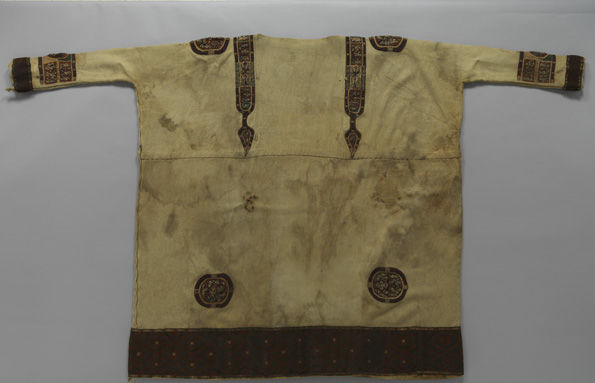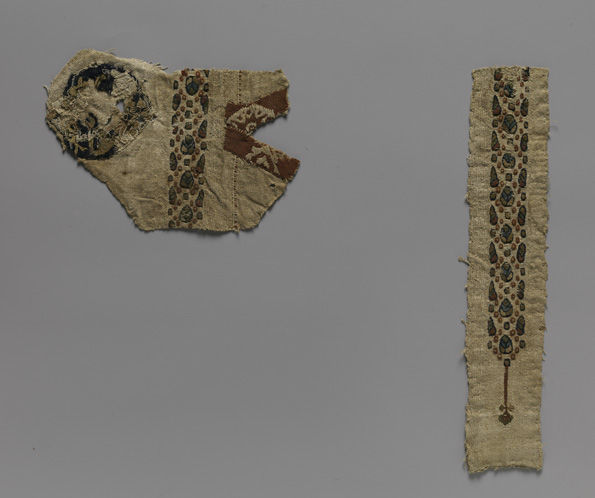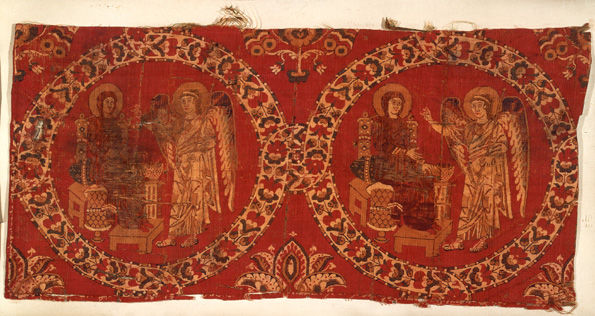In a post last week, Annie discussed how certain forms of dress distinguished cultural groups during the Byzantine era, but what about fashion and style?
Early Byzantine designs took their form and iconography from Late Antique linen garments worn throughout the Roman Empire until the fourth century. Simple in design, the T-shaped tunic was the primary garment worn by men and children, with a slightly longer tunica for women. Weaving techniques include tapestry and tabby (plain weave) for linen garments.
Richly Decorated Tunic, 660–870 A.D. Egypt, Eshmunein. Tapestry weave in polychrome and undyed wool on plain-weave ground of undyed wool; applied borders with pattern and brocading weft in polychrome wool and undyed linen. The Metropolitan Museum of Art, New York, Gift of Maurice Nahman, 1912 (12.185.2)
Tapestry-woven wool inserts incorporate figural and floral motifs rendered with subtle colorations to provide shading and detail. Sections of tapestry were rendered either as squares or circular roundels placed toward the hem, cuffs, and collar of the garment; or as clavi—long strips placed vertically from the shoulders downward. These sections comprised the majority of cost for producing decorative garments, and were often recycled and restitched when the linen became worn.
Shoulder band, fragment, 5th–6th century. Egypt. Linen, wool; tapestry weave. The Metropolitan Museum of Art, New York, Rogers Fund, 1909 (09.50.1819)
As I discussed in a previous post, technical advances in the sixth century brought silk production and weaving to new heights, allowing for greater detail and allover pattern. Silks woven on the drawloom are characterized by confronting and addorsed motifs that repeat throughout the textile in roundels or lattice framework, with special care given by designers to conceal the borders. Occasionally we see examples of repeat patterns produced on the drawloom combined with tapestry-woven roundels, as depicted on the gowns of two attendants in Empress Theodora's retinue in the mosaics of San Vitale.
Annunciation, 8th-9th century. Made in Alexandria or Egypt, Syria, Constantinople (?). Weft-faced compound twill (samit) in polychrome silk. Vatican Museums, Vatican City (61231)
The importance of iconography on textiles used as garments cannot be underestimated. Messages of identity and potency of the person underneath the cloth were delivered through this versatile medium. The pagan era of the early centuries A.D. featured depictions of gods and were adorned with vegetal motifs representing abundance or fertility, which probably functioned in a talismanic capacity. Weavers producing textiles for Christian patrons replaced gods with saints, prophets, and biblical scenes, such as the Annunciation.
Further Reading
Ball, Jennifer L. Byzantine Dress: Representations of Secular Dress in Eighth- to Twelfth-century Painting. New York, NY: Palgrave Macmillan, 2005.
Metropolitan Museum of Art. Late Antique Textiles. New York, NY: Metropolitan Museum of Art, 1995.
Thomas, Thelma K. Textiles from Medieval Egypt, A.D. 300–1300. Carnegie Museum, 1990.
Cäcilia Fluck, "Dress Styles from Syria to Libya," in Helen Evans and Brandie Ratliff, eds., Byzantium and Islam: Age of Transition (New York, 2011), 160–161.


